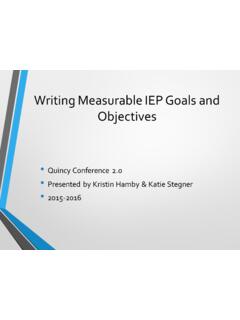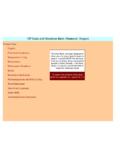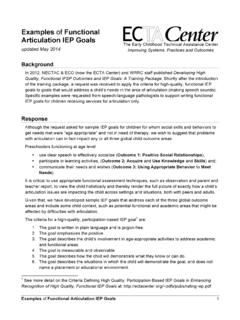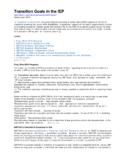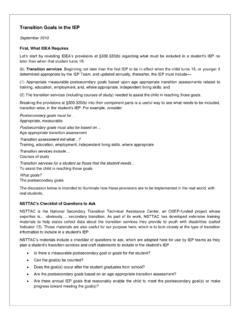Transcription of EXAMPLES OF IEP GOALS FOR STUDENTS WITH HEARING …
1 EXAMPLES OF IEP GOALS FOR STUDENTS with HEARING LOSS. BASED ON THE COMMON CORE STANDARDS. This information has been developed in line with the 2010 Common Core Standards Initiative of the Council of Chief State School Officers and National Governors Association Center for Best Practices. FUNCTIONAL LISTENING SKILLS IN THE IEP. Skill Area Area Standard Objectives Discriminates between Language K-5 Use adjectives and adverbs, and choose between Given pairs of words presented in varying degrees of loud and soft; high and them depending on what is to be pitch, volume and length, the student will identify low; long and short, etc. modified each word according to its characteristic with 80%.
2 In noise/quiet. accuracy as measured by teacher observation. Discriminate and identify Reading K-5 Distinguish long from short vowel sounds in Given pairs of vowels/consonants presented orally, vowels and consonants in spoken single-syllable words. the student will determine if they are the same or noise/quiet. different with 80% accuracy as measured by teacher observation. Discriminates between Reading K-5 Recognize and explain the meaning of common Given common phrases presented orally, the student common phrases in idioms, adages, and proverbs. will repeat the phrase with 80% accuracy as noise/quiet. measured by teacher observation. Discriminates between Language K-5 Identify real-life connections between words and When presented with a set of objects and a two- closed sets of one-four their use ( , note places at home that are element description said aloud, the student will critical elements ( , big cozy).)
3 Choose the correct corresponding object with 80 %. red ball) in noise/quiet. accuracy as measured by teacher recording. Follows one-step to multi- Language K-5 Identify real-life connections between words and Presented with a set of objects, the student will step directions in their use ( , note places at home that are manipulate the object to match the (one, two, three). noise/quiet. cozy). part directive with 80% accuracy as measured by teacher observation. Identifies a picture from a Reading K-5 Ask and answer questions about key details in a After listening text read aloud which describes an verbal description in text read aloud or information presented orally object /situation, the student will point to the noise/quiet.
4 Or through other media. correct object /situation with 80% accuracy as measured by teacher observation. From Building Skills for Success in the Fast-Paced Classroom (2011) by Kathleen A. Arnoldi. 1. COMMUNICATION REPAIR IN THE IEP. Skill Area Area Standard Objectives Repeats slowly, clearly or Speaking and Participate in collaborative conversations with During a 5-minute conversation with an adult, the in a louder tone Listening K-5 diverse partners about grade-level topics and student will repeat his response to a question more texts with peers and adults in small and larger slowly and loudly when asked for clarification 4 out of 5 times as measured by clinician tally. groups.
5 Emphasizes key word(s) Speaking and Speak audibly and express thoughts, feelings, and During a 5-minute conversation with an adult, the Listening K-5 ideas clearly. student will emphasize key words in responding to a request for clarification 4 out of 5 times as measured by clinician tally. Uses alternate words Speaking and Speak in complete sentences when appropriate During a 5-minute conversation with a peer, the Listening K-5 to task and situation in order to provide student will use alternate words in responding to a requested detail or clarification. request for clarification 2 out of 3 times as measured by clinician tally. Repeats what he thought Speaking and Confirm understanding of a text read aloud or During a 5-minute conversation with an adult, the was said Listening K-5 information presented orally or through other student will repeat what he thought was said to media by asking and answering questions about clarify 3 out of 5 times as measured by clinician tally.
6 Key details and requesting clarification if something is not understood. Ask for restatement or Speaking and Ask and answer questions about what a speaker During a presentation by a peer, the student will ask clarification Listening K-5 says in order to clarify comprehension, gather for repetition or clarification 3 out of 5 times as additional information, or deepen understanding measured by teacher observation. of a topic or issue. INCLUDING SELF-CONCEPT ON THE IEP. Skill Area Area Standard Objectives Can explain the HEARING Speaking and Report on a topic or text, tell a story, or recount During a presentation to an adult, the student will loss and its impact in Listening K-5 an experience with appropriate facts and explain his HEARING loss incorporating the following typical environments relevant, descriptive details, speaking clearly at information with 80% accuracy as measured by teacher observation: degree of loss; what situations an understandable pace.
7 Are affected; what adaptive equipment is needed. Utilizes the Speaking and Integrate information presented in different On a daily basis, the student will complete the adaptive/assistive Listening K-5 media or formats ( , visually, quantitatively) as following maintenance activities in 4 out of 5 days as equipment necessary to well as in words to develop a coherent measured by teacher checklist: clean earmolds; put From Building Skills for Success in the Fast-Paced Classroom (2011) by Kathleen A. Arnoldi. 2. make academic progress. understanding of a topic or issue. on HEARING aids; complete a listening check with a peer. Self-advocates in the Speaking and Ask and answer questions in order to seek help, During a film, speaker or presentation, the student school environment.
8 Listening K-5 get information, or clarify something that is not will seat himself preferentially (at best auditory and understood. visual advantage) in 4 out of 5 opportunities as measured by teacher observation. Handles bullying, teasing Speaking and Ask and answer questions in order to seek help, When asked by a peer about his HEARING device, the and questions about Listening K-5 get information, or clarify something that is not student will respond appropriately ( , explain what HEARING loss understood. it's for and/or why they wear it) in 3 out of 5. appropriately. situations as measured by staff observation. Informs peers in a Speaking and Ask and answer questions in order to seek help, When asked by a peer about his HEARING loss, the positive manner when Listening K-5 get information, or clarify something that is not student will respond in a positive manner ( , asked about HEARING loss.)
9 Understood. explain about the HEARING loss) in 3 out of 5. situations as measured by staff observation. SELF-ADVOCACY ON THE IEP. Skill Area Area Standard Objectives Chooses own seat to Speaking and Ask and answer questions in order to seek help, During a typical classroom activity, the student will maximize visual and Listening K-5 get information, or clarify something that is not seat himself to maximize their auditory and visual auditory access understood. input in 4 out of 5 situations as measured by teacher observation. Informs the speaker of Speaking and Ask and answer questions in order to seek help, During a typical classroom activity, the student will the need to position Listening K-5 get information, or clarify something that is not request the speaker to position himself to maximize himself optimally (no understood.
10 Student auditory and visual input in 4 out of 5. obstructions, face the situations as measured by teacher observation. student, in best light, etc.). Gives the FM transmitter Speaking and Integrate information presented in different During a transition to another classroom, the student to the speaker Listening K-5 media or formats ( , visually, quantitatively), as will present the transmitter to the next teacher in 5. well as in words to develop a coherent out of 6 classes, 4 out of 5 days per week as measured by teacher recording. understanding of a topic or issue. Requests an interpreter Speaking and Ask and answer questions in order to seek help, At least two weeks prior to the event, the student for activities (field trips, Listening K-5 get information, or clarify something that is not will request a sign language interpreter, providing all co-curricular activities, understood.



